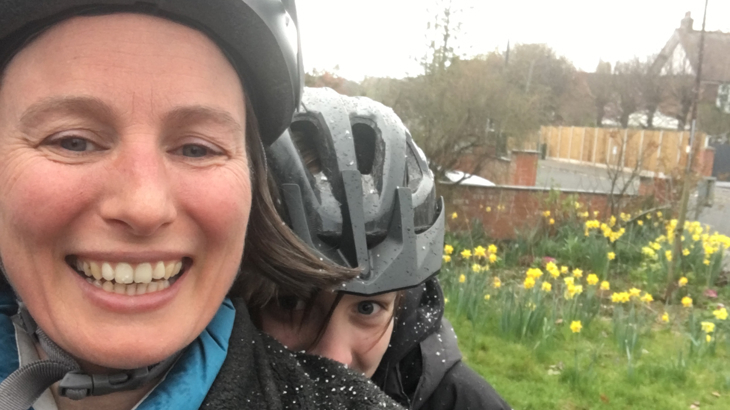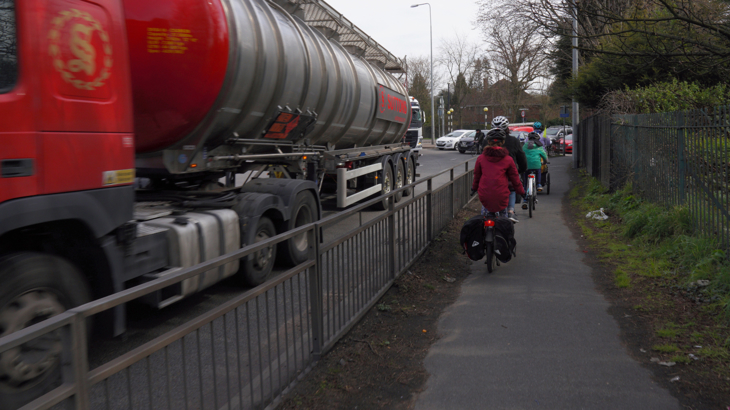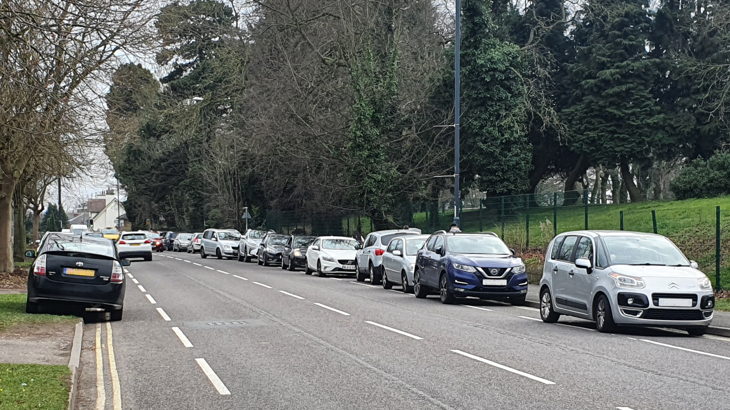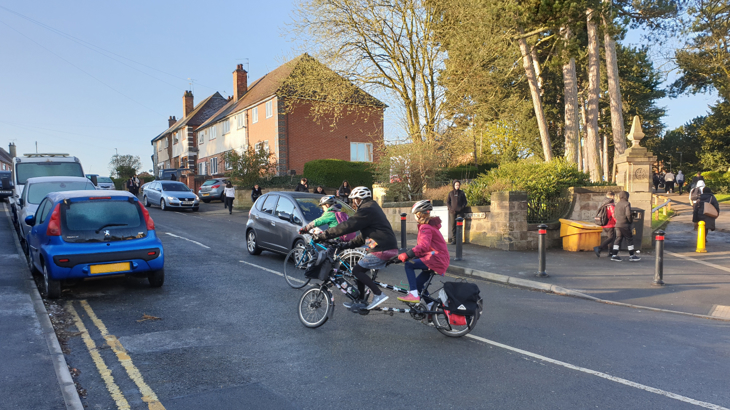Guest blogger Kate Ball shares stories from her life as a disabled mother of four children, two of whom are neurodiverse. Kate and her family love cycling but it’s not without its challenges, and these aren’t as personal or unique as you might think. Kate explores the extent to which we’re all disabled by our built environments and habitual attitudes.

Our guest blogger Kate is a disabled mother of four children, two of whom are neurodiverse. Photo: Kate Ball
My whole family loves cycling.
We cycle most of our journeys, everything from hospital appointments to holidays.
I have arthritic damage which gives me back and leg pain, along with weakness.
I can only walk very short distances and only cycle with electric assistance.
Two of my four children are neurodiverse, with diagnoses of ADHD and autism.
One is also learning disabled, and while she’s great at pedalling and balancing, she needs someone else to start, stop and steer.
We’ve used a wide range of cycling kit, from child seats to trailers and tag-a-longs, three different tandems, and a host of single cycles from balance bikes to Bromptons.
Having this kit has helped us to keep cycling, but the built environment is still a massive problem.
The path along the edge of a dual carriageway
Our school run unfortunately showcases several of the challenges which we face when it comes to everyday cycling.
The most direct route to school has zero crossings over the major roads.
It’s not even worth discussing cycling on this route.
The next best has difficult crossings and a narrow shared-use pavement which runs alongside a 40mph dual carriageway.
This pavement has a crossfall which slopes towards the traffic, which is enough to put many people off, and it clearly does.
Roadside paths can leave us all feeling unprotected, both from motorised vehicles and air pollution.
But for my neurodiverse children and people like them, being so near to busy roads can be emotionally overwhelming too.
My children struggle with anxiety, experience sensory overload and need a bit longer to process what’s happening around them.
What’s more, when a shared-use pavement isn’t consistently and clearly signed for walking and cycling, an autistic person may feel uncomfortable and even distressed, perceiving all pavement cycling as unacceptable rule-breaking.

On their way to a local park, Kate and her family encounter congestion and air pollution alongside intimidating roads. Photo: Hardy Saleh
The quiet but fast road
The third route option is to cycle twice the distance of the driving route on a fairly quiet but fast road.
My nine-year-old cycles independently but he is vulnerable, so when we’re on roads, I must cycle on the outside to provide both safety and support.
Holding the line to cycle two abreast on the road can be daunting and intimidating.
Many people in cars seem to resent this right being exercised, despite it being permitted in The Highway Code.
If cycling to my children’s school on this road feels impossible, all options have now been exhausted.
Poor infrastructure can pose huge challenges and barriers to disabled and neurodiverse people, but you don’t have to be disabled to experience barriers to cycling.
We don’t need to look at national surveys to know that most people find these route options unsafe and uncomfortable.
We just need to look at how few people are using them.
As a case in point, we are the only family who regularly cycle on roads to this large urban primary school.
Decision makers need to realise that so-called cycling infrastructure like this serves so few and disables so many.
The school road filled with pavement parking
If you manage to get to the road which the school is on, there are a fresh set of challenges to navigate.
Here, people parking on the pavement roll vehicles on and off the footway, with wing mirrors passing inches from children’s heads.
Idling engines spew out fumes as air-conditioned interiors isolate the passengers from the community around them.
It’s a fraught and unpredictable environment for everyone outside the protection of motorised metal boxes.
Cycling here is a constant stop-start due to hazard avoidance.
A hectic space like this is confusing for anyone, but especially for neurodiverse children.
It can leave them thinking ‘are we or aren’t we stopping and getting off?’
It’s one of the reasons that I had a rear-steer tandem which put me in control at the rear of the cycle and my child upfront in my line of vision.
It meant I could prevent random and premature dismounts.
And yes, prior to owning a rear-steer, I did leave a small child on the wrong side of a road crossing because they hopped off without me knowing.

Pavement parking and parking across cycle lanes, creates an unpredictable and hazardous environment for anyone walking, wheeling or cycling to this large secondary school. Photo: Tony Mott
Conflict roulette
My experience is that urban cycling is about choosing the least stressful or dangerous type of conflict to put myself and my children in.
Our presence on both shared-use pavements and roads seems to be frequently unexpected or resented by people walking and driving alike.
Many people also don’t seem to realise that not everyone can dismount and push a cycle up or along a pavement.
Cycles are some people’s mobility aids, and this might be for physical, cognitive or psychological reasons.
If you need to cycle a pre-planned route, for example if you are learning disabled or autistic, unexpected changes such as poor parking or road works can end your intended journey.
Asking an autistic child who is already coping with sensory overload and road anxiety, to dismount or change route unexpectedly, can be the difference between a happy, successful outing, and a distraught child trapped in a prolonged meltdown.
For many disabled people, one badly parked car can result in pain, fatigue, missed medications, fear or illness.
It can ruin a whole day, and the confidence to go out again in the future.
All of these risks can make active travel highly unattractive.

Kate finds that urban cycling is a case of choosing the least stressful or dangerous type of conflict to put her and her children in. Photo: Kate Ball
The unfriendly traffic-free path
I'd love to say it's nice to get away from the streets and onto the safe, quiet, traffic-free paths.
Except often we can’t.
Recently, we checked out a local, recommended cycle ride on the National Cycle Network.
I was delighted to see that there was no mention of any barriers in the accessibility details.
And then at the entrance of this former railway line, we discovered an all too familiar A-frame barrier.
There was no way that our e-tandem was going to fit through.
Moreover, this bike weighs 25kg - that’s more than five times what I can reliably lift.
And if you think that’s heavy, our rear-steer tandem was over 50kg.
Upset and frustrated we went off in search of consolatory ice creams.
I first asked my local council to remove the barriers on this particular route back in 2010.
It’s now 12 years later and nothing has changed.
This is far from the only barrier on the National Cycle Network, or at the entrance of a public park, green space, or community cycle path.
And we’re far from the only people who need bigger cycles.
Here’s a snapshot of some other people who also can’t gain access to a lot of traffic-free paths and green spaces:
- A baby being pushed in a buggy by their grandparent - perhaps this is their only access to green space.
- A person riding a cargo bike - perhaps they’re making local deliveries for work.
- A person riding a trike - perhaps vertigo affects their balance.
- A couple riding a tandem - perhaps one is visually impaired.
- A person using a hand cycle - perhaps it suits their range of movement.
- A person using a recumbent cycle - perhaps arthritis makes sitting on a bike painful.
- A dog owner cycling with a pet trailer - perhaps their dog enjoys the park but can’t walk there.
- A person using a mobility scooter - perhaps they’re recovering from an injury.
- People cycling trishaws - perhaps a carer is taking an elderly client out for the day.
Can you honestly rule out ever being one of these people?
Probably not, which is why my family’s barriers to cycling are yours too.
Am I contradicting myself?
At this point you may think there’s a contradiction in what I’ve said so far.
After all, I’ve told you that we cycle most of our daily journeys and that we love cycling.
It’s all true, so does that mean that I’m just making a fuss about nothing?
No.
I’ve only had a significant mobility impairment for two years.
Before that, I could cycle anywhere on a bike.
I could also run along a pavement accompanying small children on bikes.
My two older children were both able to cycle on quiet roads next to an adult before they were five.
These years of previous experience have made both teaching our two neurodiverse children to cycle, and getting myself back to cycling as a newly disabled adult, much, much easier.
I can’t imagine how, or if, I would have tackled this if I wasn’t already cycle confident and committed to active travel.
Many parents of disabled and neurodiverse children don’t have the time, confidence or inclination to undertake the intensity of training which their children would need to learn to cycle.
And even if they do, they live with the ongoing fear and risk of their child being hit by a driver who’s not going to accommodate them on the road.
Or their child being disproportionately harassed by members of the public.
None of us should have to live with this fear or risk, for our loved ones or ourselves.

Teaching neurodiverse children to cycle can require intensive training, and a hostile built environment only makes this more challenging. Photo: Hardy Saleh
Are we all cycling disabled?
You’re disabled under the Equality Act 2010 if you have a physical or mental impairment that has a ‘substantial’ and ‘long-term’ negative effect on your ability to do normal daily activities.
Cycling should be a normal daily activity, but over 60% of adults agree that it is too dangerous to cycle on the UK’s roads.
The social model of disability explains that people are disabled by their environment, not their impairment.
So in reality, the majority of us are being disabled by the roads around our homes and the people who drive without consideration for those who are walking, wheeling and cycling.
Whether disabled or without impairment, we’re all having our ability to go where we want, when we want, with whoever we want, negatively affected by poor infrastructure and inconsiderate behaviour.
The thing is, it’s often the 22% of the UK population who are disabled who are the first to be negatively affected and are affected to the greatest extent.
If you’re a decision maker, town planner or urban designer, our lived experience makes us the best consultants, allies and collaborators around.
We can tell you how to create places for everyone, if you’re willing to listen.
Making our streets for everyone
If you’re not in a position to change infrastructure, you might be thinking ‘is there anything I can do?’
Absolutely. All of us can play our part in creating places which are safe for everyone.
Here’s my own personal list of four key behaviours which I believe many of us can action:
1. Walk, wheel and cycle with care and consideration:
- Take it steady and slowly in shared spaces.
- Give space to other users.
- Say please and thank you.
- It’s not about you knowing that you’re not going to knock into someone else, it’s about them having the confidence that you won’t.
- Check out Sustrans’ Share, respect and enjoy guidance.
2. Drive with care and consideration:
- Don’t park on pavements, even just partly or for a short while.
- Drive steadily and predictably so others can gauge your speed, distance and direction.
- Respect the choice to cycle two abreast.
- Overtake cycles and mobility scooters generously and slowly.
3. Use your voice:
- Report problems such as potholes, unlevel drop-kerbs and poor drainage to local councils.
- Ask your local authority* to re-design barriers on traffic-free paths, parks and green spaces.
4. Never make assumptions about someone else’s physical or neurological abilities:
- Remember not everyone can dismount and push their cycle.
- Not everyone can control their emotions or reactions.
- The world can be overwhelming and challenging, but we can all do much more to look out for one another in many different ways.
*Most of the National Cycle Network (the Network) is owned by local authorities, along with most community paths, parks and green spaces.
As custodians of the Network, Sustrans is working with communities and partners, including local authorities, to redesign barriers and make the case for redesigning more.
To support our work, we need thousands of local voices to speak out against the poorly designed physical barriers, chicanes and gates which are locking out millions of legitimate users and effectively disabling them.





